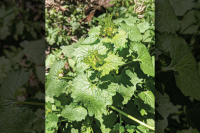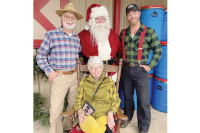Waynesville could finally see long-awaited make-over of South Main Street
Waynesville’s South Main Street — the two-lane thoroughfare that is the major artery between downtown and the new Super Wal-Mart — could be increased to four lanes and even have roundabouts, according to preliminary redesign options recently laid out by the Department of Transportation.
Town officials have been hounding DOT for more than a decade to redesign the corridor, which also serves as one of the gateways to Waynesville.
The DOT made forays into a feasibility study for the road in 2002, but the plan went nowhere and was shelved.
South Main Street is now back on the drawing board. Town leaders are hopeful the DOT will come up with a redesign that fits in with the town’s land use plan and makes South Main Street more pedestrian friendly and aesthetically pleasing.
South Main Street has long been the neglected end of town. The need to redesign the dated corridor has grown more urgent since the arrival of Super Wal-Mart in 2008. The two-lane road is no longer able to handle the amount of traffic that has been added as a result of the megastore and buildings that have sprung up around it. According to DOT, 18,400 vehicles per day are coming and going in the vicinity of Super Wal-Mart.
“We needed something addressed,” said Mayor Gavin Brown. “It’s not going to go away — it’s an issue and it’s a problem.”
DOT has laid out several redesign options to study. One calls for widening the thoroughfare to four lanes from Hyatt Creek Road, just next to the Super Wal-Mart, all the way to U.S. 276 right at the edge of downtown. A raised median would be placed in the middle.
Another option calls for widening the road to four lanes about half way to downtown — near the Waynesville Inn Golf Resort and Spa, i.e. country club — then to three the rest of the way. Roundabouts could be included in the three-lane section.
A third option would maintain the road as a two-lane corridor and implement intersection improvements such as roundabouts.
The options differ from those offered up in the 2002 study, before the town’s land use plan was in place. That study recommended a four-lane divided road with extra turn lanes in some places at a cost of $27 million. The old study estimated that 30 businesses and a dozen residential homes would be displaced by the redesign.
Starting early last year, town officials pressed DOT to revisit the feasibility study so it incorporated the town’s land use plan. The town opposes major widening of the road all the way into downtown or through residential stretches, Brown said.
In the commercial area, the town does not want a five-lane road, Brown said, preferring a four-lane road with a landscaped median in lieu of a middle turn lane.
In addition, the town wants eight-foot wide sidewalks on either side of South Main Street to accommodate bicycle and pedestrian traffic and street trees lining the corridor.
“Sidewalks are necessary for the safety issue — people are going to walk to these facilities,” Brown said, referring to the new Super Wal-Mart, Best Buy, and other businesses that have cropped up around them. Currently, the sidewalks lining South Main Street are patchy at best, and at points, disappear completely, leaving pedestrians dangerously close to oncoming traffic.
The initial plan didn’t include sidewalks — in fact, the new plan likely wouldn’t either if the town didn’t make it a priority to push for them.
“The DOT is very focused on automobile transportation, and they talk about being multi-modal, but I’ve seen them be pretty reluctant to include things like bike lanes and sidewalks because its an extra expense,” said town planner Paul Benson. “If the town wants to see amenities like that, we’ve got to get involved.”
By all indications, that’s just what Waynesville officials have done. Brown said he’s called the DOT every two months for the past year to check on the status of the study.
In an telephone conference with DOT designers in January, the town voiced concern over whether an overly wide road would be compatible with the town’s design guidelines and vision for the corridor. Town officials reiterated their wishes for sidewalks and street trees.
Brown said the regional DOT office has been very willing to work with the town and has helped them communicate their wishes to the state office.
“They completely understand the town’s vision and were very supportive of my comments,” Brown said of the regional Division 14 office.
DOT Feasibility Studies Unit Head Derrick Lewis cautions that the new designs being studied could change depending on the input of local leaders.
“We’ve changed our process to actively solicit government input at multiple points within the process,” Lewis said. “We’re just trying to get it closer to what everybody wants, and we actually get a better product in the long run.”
Lewis said the DOT will also seek public input early in the process, before the final designs are laid down. Members of the public will be invited to share their ideas and concerns at a workshop this summer.
Town officials promise to be vigilant in making sure the final product reflects the town’s vision.
“If we don’t like what we see, we’ll lobby for changes,” said Benson.
Waynesville land use plan back on the drawing board
Waynesville leaders will finally kick off the town’s much-anticipated review of its six-year-old land use plan on April 22.
Town aldermen have hired the Davidson-based Lawrence Group, renowned in planning circles, as the consultant for the project. A $10,000 grant from the Community Foundation will pay for a portion of the $54,000 consulting fee.
The lead consultant, Craig Lewis, will be in Waynesville Wednesday, April 22, through Friday, April 24, to interview stakeholders and attend a meeting of the land use plan steering committee.
Stakeholders will be selected individually and could include the county Board of Realtors, Chamber of Commerce and Economic Development Commission, for example. Mayor Gavin Brown had a broad definition of what a stakeholder is — “basically anybody in the community that’s involved in the use of land in Waynesville.”
However, Brown said the process will place particular importance on collecting feedback from developers.
“To be quite honest, this (review) is geared to some extent toward the developer segment of the community,” Brown said. “The last go around, for whatever reason, they weren’t engaged, and now we’re trying to engage those folks.”
Mounting complaints from developers that the strict architectural guidelines and other aesthetic criteria are too arduous prompted town aldermen to launch a review of the land use plan. Town leaders resisted making piece-meal or knee-jerk changes to the plan’s smart growth principles, and instead opted for a thoughtful and comprehensive review of the pros and cons of the town’s development standards.
The stakeholder interview process is not the same as a public hearing, which is planned though a date has not been set. Brown assured the public will get a chance to have their say at some point.
“There’s no question about that — I believe in everybody having their say,” Brown said.
Town planner Paul Benson said at least two public hearings must be held according to law, and he hopes the town will hold even more. But Benson added that the public already has a voice in the process through the eight members of the land use plan steering committee, which was appointed by alderman.
“The general public basically has eight permanent seats in the process,” Benson said.
Before public hearings are held, town officials and stakeholders will work with the consultant to amend various sections of the land use plan, bringing each section back before the land use plan steering committee to review. In total, 29 districts will be reviewed, and Benson says they’ll all receive equal attention.
What is the Waynesville land use plan?
Waynesville’s land use plan is based on smart growth principles. It requires commercial developers to build sidewalks, plant trees along the street and in their parking lots, and adhere to architectural standards. Signs are kept short and parking lots are kept small, or at least not oversized. Parking is placed to the side or rear so that building facades and not parking lots define the streetscape.
Affordable senior condos spark opposition among downtown Waynesville neighbors
Residents of a downtown Waynesville neighborhood are up in arms about a proposed three-story, 64-unit condo development that would provide affordable housing for senior citizens — and, they fear, also lower the property values of their homes.
The development, called Richland Hills, is under the wing of Asheville-based nonprofit Mountain Housing Opportunities, which has several developments in Buncombe County. Rent will range between $300 and $500. To be elligible, you have to be over 55. There is also an income cap.
“Low income is not going to fit here,” said neighbor Lela Eason, who is leading the opposition to the development. “This is a well-established neighborhood, and it will completely change the face of it.”
Mountain Housing Opportunities Project Director Cindy Weeks contends that the neighbors would like the development if they understood it better. The architect designing the building is the same one who worked on the Laurels of Junaluska, another senior development in the county, and the building will use green features.
At this point, there’s probably little Eason and her neighbors can do to halt the project, said Town Zoning Administrator Byron Hickox. The project has already been approved unanimously by the town’s planning board and community appearance commission. It meets all the required building, architectural and landscaping guidelines.
The development is located in the East Waynesville Neighborhood District, where high density development is allowed, said Hickox. Town zoning allows for 16 units per acre in that area, and though Richmond Hills will be three stories tall, it still falls just under the maximum allowed height of 35 feet.
None of that has deterred Eason and her neighbors from waging a protest against the development. Eason faults the town for not informing her community of the development sooner. She says her sister-in-law was the only person to get a letter notifying of the proposed project, and that only came last week.
“It’s kind of sneaky that the whole community doesn’t know about it,” Eason said. “There are people who can see it from their properties who are furious, and they have no clue it’s about to take their property values down.”
A poor fit?
A sheet of paper being passed around the East Waynesville district accuses the proposed Richmond Hills development of catering to low income individuals at poverty level. The paper states that drugs are sold out of similar communities in Asheville, and that the safety of the neighborhood may very well be jeopardized should this development be built.
The “low-income” stigma is one Mountain Housing Opportunities has battled many times in its 20-year history. The idea that the nonprofit builds housing projects is incorrect, says Project Director Cindy Weeks.
“People in their heads have some idea about public housing, but that’s not us,” Weeks said. “Nothing about this will be remotely related to public housing. We’re very selective about tenants, and we get background checks and even credit checks.”
Weeks is used to dealing with skeptics. Her answer? She tells them to check out the non-profit’s other developments.
“One-hundred percent of the time, they’ll come back and say it’s beautiful,” Weeks says. Contrary to the reported drugs sold in these complexes, “we’ve never had problems with neighbors; no complaints; no police problems,” she says. “Here in Asheville, it’s gotten to the point where we don’t have much concern over what we’ve built.”
But Mountain Housing Opportunities is dealing with unfamiliar territory in Waynesville. The Richmond Hills project is the group’s first outside Buncombe County. The town was picked based on the results of a market study the nonprofit conducted, which identified Waynesville and Haywood County as having a need for senior apartment homes.
“There’s a lot of seniors in the western part of the state that might be living in substandard housing, not close to medical services or shopping,” Weeks said. “This would be an alternative for them.”
Weeks said a downtown Waynesville location seemed ideal for its accessibility, among other reasons.
“What we liked about the location was that it was well-located to shopping and services in the downtown,” she said. “The site is relatively flat and easy to develop, and we can get access to utilities. Plus, it’s just a nice neighborhood.”
Maybe a little too nice for such a development, says Eason. A one-story, high-end apartment complex would be a better fit, she says — the Richmond Hills complex might be better suited to other areas of the county.
Downtown Waynesville Association Director Buffy Messer doesn’t agree. She says the development will be a good fit downtown.
“I think its actually a very good addition to the area,” Messer says. “We are encouraging more residential in the downtown area. The goal is to expand both shopping and residential.”
Messer says she thinks fear is the driving factor of the opposition to Richmond Hills.
“In many other cities with what is considered low-rent housing, there have been some serious situations with drugs, alcohol and domestic problems,” Messer says. “But we already have some affordable housing throughout the town of Waynesville that probably people don’t even know about.”
Messer says the development is a good way to get seniors living downtown.
“I think so many of our seniors are having to move outside the town and county because we don’t have affordable options,” she says.
With an income cap to qualify, however, it is unclear whether residents will be big patrons of downtown shops. Similar developments by the same entity in Asheville have an income cap of $22,000.
Too late?
Hickox says the residents of the East Waynesville district should have raised their protests earlier.
“The bottom line is that now is not the time to make the argument of if it’s a good fit for the community,” Hickox said. That should have been done more than six years ago, when the zoning guildelines were established that allowed for high density development in the district.
“If you wait until they’ve already proposed the project, you’re too late; you’re too far behind,” said Hickox. “If it meets the standards, the town doesn’t have the legal ability to deny it.”
The Richmond Hills project still has to go before the town Board of Adjustment — the final step before it’s approved. That meeting isn’t really for public comments, Hickox said. Those could have been given at the planning board and community appearance commission meetings. Someone making a case before the Board of Adjustment needs to present hard evidence of why the project shouldn’t be allowed. An example would be a history of traffic patterns in the area and evidence of why the project would clog traffic.
The Board of Adjustment meets on Tuesday (April 7), just after The Smoky Mountain News has gone to press. If Richmond Hills is OK’d — and there’s no indication it won’t — Mountain Housing Opportunities will start getting financing in place.
Construction of Richmond Hills is slated to begin within six to eight months — but not without a fight, vows Eason.
“We have a community crying out saying ‘no,’” she says.
New face on Waynesville board: Funeral home director fills Kenneth Moore’s seat
One would be be hard-pressed to find someone uttering anything but praise for new Waynesville Alderman Wells Greeley.
The 6-foot, 5-inch former college football player and one-time Canton alderman is a well-known and well-liked figure about town. In his role as fourth generation director of Wells Funeral Home, Greeley has helped shepherd numerous residents through some of their most difficult times — and garnered an impressive level of respect doing it.
“I think he’s a great guy and a great choice for Waynesville,” said Canton Mayor Pat Smathers, who has known Greeley for years.
Greeley was picked by town aldermen to serve out the remaining term of the late Kenneth Moore, who passed away March 2. Greeley says that’s left him with some big shoes to fill.
“Kenneth Moore has left such a legacy of service and dedication in his tenure as an alderman,” Greeley said. “He was a champion of the little guy, and I would really hope to carry on the accessibility that he always had. But that will be a tough act to follow.”
Here’s a little bit more about Greeley, including some of his views on issues currently confronting the town.
Smoky Mountain News: Why did you want to be alderman?
“It’s a level of political involvement that I think is rewarding, because you live right in the community and are accessible on a daily basis to the people you’re serving. I don’t really have visions of political grandeur — I just enjoy this level of service at the town level,” said Greeley.
SMN: What makes you a good alderman?
Greeley says his background has prepared him for the position. His experience as an alderman in another town has provided him with a unique view of things.
“I think the fact that I interact with people throughout the county and in both towns gives me a perspective that will be ultimately valuable in making decisions,” he says.
He also says his job as a funeral director has let him interact with citizens from the whole spectrum of backgrounds and incomes.
“My vocation puts me at all levels of population in this county,” he says.
Greeley has other traits that qualify him for his position.
“I’m pretty much a team player and I don’t come to this job with any other agenda other than being able to serve and give something back to the community,” he says.
SMN: What were some of your accomplishments in your previous role as an alderman?
Greeley served as an alderman in Canton from 1981 to 1985. Though his experience was years ago, his tenure means he’s confronted issues at the town level before. As a Canton alderman, Greeley was involved in several annexation and zoning issues. He also helped push for beautification of the downtown area. In addition, he and the board declared Rough Creek Watershed a natural area, laying the groundwork for the opening of the watershed for hiking and biking.
Greeley points out that Canton and Waynesville, “are two totally different venues.” He says Waynesville represents a more tourist-oriented setting. Even though each town possesses its own unique set of problems, Greeley says cooperation will be important when dealing with future challenges.
“There are real partnering relationships that may need to occur,” he says.
SMN: What are your feelings on growth?
Greeley says he’s generally supportive of the current aesthetically friendly development standards and smart growth principles in place.
“Growth is a wonderful thing. It’s got to be controlled growth, but not to the standpoint where its infringing on people’s rights,” he says.
Greeley thinks the land use plan has been successful in its goal to improve the town’s appearance, particularly along the Russ Avenue corridor.
“I’m very pleased in terms of Russ Avenue,” he says. “If I’m an advocate for something, I’m an advocate for the aesthetics of how (the town) will appear for residents and visitors.”
Greeley says the town needs to be careful in granting variances, or exemptions, to the land use plan. Businesses frequently ask for these, and some have criticized the land use plan for not being flexible enough and discouraging industry.
“Variances are something that demand a lot of attention because the minute you allow a variance in one aspect, it no doubt affects another,” he says.
Though he supports the land use plan as it currently stands, Greeley also supports a review of the plan to make sure it’s effective. A five-year review of the plan is currently under way.
“To me, every piece of legislation and every ordinance in the town is subject to review on a continual basis,” he says.
Greely thinks the next big area where the land use plan will be tested is in the South Main Street corridor, which has experienced rapid growth recently with the arrival of Super Wal-Mart and other big stores.
“I think we need to pay particular attention to that and keep it sidewalk and bicycle accessible,” he says.
Related to that, Greeley says he will make the continued development of the town’s greenway an issue of primary importance.
SMN: How will you handle the budget?
W.G. “The budgeting is going to be a real challenge,” Greeley admits. “The one thing I will do very diligently is pay attention to line item expenses to, if nothing else, cast a new set of eyes to say, are there any economies of scale we can possibly save.”
Officials: Appointment process is suitable
Three others also vied for the alderman seat filled by Wells Greeley — Waynesville residents Julia Freeman, Ron Reid, and Bruce Carden, according to Alderman LeRoy Roberson. Roberson says he was surprised more didn’t apply.
“I think part of it is that people have been satisfied with the way the town’s being governed,” Roberson speculated.
The town board has received some criticism over the informality of the selection process. Candidates verbally notified alderman of their interest, then filled out a questionnaire asking their views on town issues. If board members had further questions, they met with candidates individually. The interviews weren’t conducted in public.
Mayor Gavin Brown has defended the process, and so does Roberson.
“Quite honestly, this was much more open than any of the previous times,” Roberson said. “When I first served on the board in 1991, the questions that I had were: would you like to serve on the board, and then the next thing, I was on the board.”
State guidelines provide little guidance on filling vacated town board seats, so the process was left up to the discretion of the town board.
“I’m sure there’s a better way, I just haven’t seen one that’s going to be better other than holding an election, and I don’t think that’s really necessary,” said Roberson.
Cause of quarry slide undetermined
Federal investigators with the Mine Safety and Health Administration have still not determined the cause of a slide last week that sent a 600-foot slab of rock crashing down at a Waynesville rock quarry.
No one was injured in the March 12 slide at the quarry, which dislodged 480,000 tons of earth and buried a drilling rig. The quarry is located in the Allens Creek area and owned by Harrison-APAC, Inc.
Amy Louviere, spokesperson for the federal mine administration, said a closure order is still in effect in the part of the quarry where the slide occurred until the operator comes up with a plan to prevent future slides. The operator could be fined if it is found to be in violation of mining safety regulations. Men had been working in the area earlier that day, but the slide happened after quitting time.
State geologist Rick Wooten said such a large slide in a quarry is an unusual occurrence.
“This is the first major one that I’m aware of in Western North Carolina since I’ve been working out here,” Wooten said. “It’s certainly not a common experience.”
Louviere agreed that despite the nature of quarry operations, slides are not common.
Just last month, the quarry became the only aggregate mine in the state to receive a Mining Star Award for implementing outstanding safety programs.
— By Julia Merchant
Churches pool to offer refuge for homeless in Sylva, Waynesville
A homeless shelter has opened in Sylva to provide an escape from the frigid nights.
The shelter, located at Lifeway Church in Sylva, is the only homeless shelter in Jackson County. It will remain open through March.
About a month ago several local organizations met to discuss the need for a homeless shelter amid fears the spiraling economy would leave people with nowhere to turn.
Local churches have committed to staff the homeless shelter in Sylva with volunteers.
The shelter is working in partnership with the Community Table to provide meals.
Lifeway Pastor Mike Abbott doesn’t know how many homeless people there are in the Sylva area, but said, “We definitely have homelessness.”
With the winter being so cold this year, there needs to be a place for them, he said. The shelter opened about two weeks ago, and as of Sunday (March 1) no one had stayed there.
He said the homeless may not realize it’s there or they may have gone south or to Buncombe County by now. The shelter is open from 7 p.m. to 7 a.m. seven days a week.
Abbott said the plan is for Lifeway to host the shelter again next year with it opening Nov. 1.
“I’m excited that in a relatively short period, community organizations and churches were able to come together and accomplish opening this up,” Abbott said. “This speaks well of the community. A lot of good people made this happen.”
The shelter can accommodate about 20 people and there is additional space for women with children and families, he said.
Mountain Projects Executive Director Patsy Dowling said the economy is causing people who normally wouldn’t need help to seek assistance.
“More people are losing their jobs and their healthcare,” she said. “The faces of people in need are changing.”
Many people who have lost their jobs and need food stamps can’t get them because they have assets that preclude them from qualifying, she said.
Laid off employees are having trouble paying their rent and can’t get help because the rental assistance program waiting list at Mountain Projects is “years long,” said Dowling.
Utility bills are becoming harder to pay for people affected by the economy.
Churches in Haywood County have banded together to open a homeless there, too. Space is being provided at Camp New Life.
Dowling spearheaded the community meetings to bring the homeless shelters to Jackson and Haywood counties. Her interest was sparked in December when there was a homeless couple in Waynesville that needed a place to stay.
There was nowhere in Waynesville and nothing available in Asheville. She felt bad that the only thing Haywood County could offer the couple was gas money to get to a shelter in Tennessee.
“We should have a place for people to get back on their feet,” she said.
Asked if she thinks it took too long to get shelters open in Jackson and Haywood counties, Dowling said she is not going to look back.
She said there is also a need for food and clothing, noting that the Community Table may expand its hours and her church in Tuckasegee may open a food pantry.
Dowling has a long list of heartbreaking stories, including a 61-year-old woman who can’t afford heating oil and groceries.
“I hear so many stories of people who were making $20 an hour last year and now are walking into my office with utility disconnect notices,” she said.
Waynesville mourns passing of long-time alderman
Waynesville Alderman Kenneth Moore passed away Monday (March 2) after a heart attack. He was 74.
Moore was the former police chief of the town of Hazelwood, and had been an alderman since 1995. He was serving his fourth term.
“All of us are devastated that this community has lost such a fierce advocate,” said Alderman Libba Feichter. “He didn’t say a lot, but was absolutely, fiercely loyal to his community.”
Colleagues remembered Moore as someone who genuinely cared about, and went to bat for, the people he worked with and served.
“His belief was rules are rules, but people are people — and people are more important than rules,” said Mayor Gavin Brown.
Moore went out of his way to show interest in the lives of people who knew him. Town Clerk Phyllis McClure remembers that when her grandson fought cancer, Moore never missed a chance to call and check on him.
“He was always looking out for citizens, town employees, and their families,” said McClure. “We really will miss him.”
Feichter said Moore was a tireless advocate for town employees.
“He wanted to make sure that they caught every break, that we made sure they were cared for, and that their salary was fair and equitable,” she said. “He was just a fierce advocate for those people and the people of his community.”
Though Moore’s seat is now empty, his legacy lives on. Brown credited Moore as the first to pitch the construction of new fire and police departments. Moore was able to see his goals realized —the fire department was completed last year, and construction of the police department is well underway.
The other four members of the town board will appoint Moore’s replacement, who will serve until the next regular town election.
Paver design chosen for Waynesville police station
Courtney Boessel’s “Patchwork Community” was chosen as the winning entry for Waynesville’s new police station paver design as part of a contest sponsored by the Waynesville Public Art Commission.
The contest was designed to build community — and also to build public awareness of town history — and was open to Tuscola High School art students.
Given the theme “A Heritage of Service and Friendship,” the students were asked to submit sketches of a brick paver design to be installed at the outdoor plaza area in front of Waynesville’s new police station. The design concept needed to be site specific, reflecting the history and past uses of the location. In the past it had been a livery stable, a town hall, chamber of commerce, fire and police departments and the Downtown Waynesville Association headquarters. The site has also served as a gathering place, promoting fellowship among citizens and visitors, during numerous festivals including Folkmoot.
Three sketches were chosen as finalists from among those presented by Tuscola teacher Donna Rhodes’ art class. In addition to Bowessel the finalists were Kelsey Jaynes’ “Tri-umphant” and Patrick Burke’s and Cory Plott’s joint effort titled “Where We All Come Together.” Boessel, submitted her drawing titled, “Patchwork Community.” The three finalists made a formal presentation, each with a detailed rendering and written explanation of their concept, to a selection committee consisting of citizens and town officials.
Boessel explained that her concept pays homage to the venerable craft of quilting. The focal point of the walkway in her design is a giant log cabin square, a popular quilting pattern in our region. “From the log cabin days of early pioneers to the thriving commerce and growth of our town today, we are a patchwork of cultural diversity, strength, talent, accomplishment and promise,” she said.
The two finalists were awarded $250, and Boessel was awarded $750. All three drawings will be on display in the lower level of the Haywood County Public Library on Haywood Street in downtown Waynesville, beginning Feb. 14.
Established in 2006, the Waynesville Public Art Commission was appointed by the Town of Waynesville to develop a public art plan. Choosing themes that are unique to Waynesville, the commission’s purpose is to bring art to public sites, resulting in a permanent art trail for residents and visitors to enjoy.
The commission dedicated its inaugural piece titled “Old Time Music” in October 2008 at the corner of Miller and Main street in downtown Waynesville.
To learn more about the Waynesville Public Art Commission and their projects, contact the Downtown Waynesville Association at 828.456.3517, or visit the Town of Waynesville Web site at www.townofwaynesville.org and press on the public art tab.
Waynesville land use plan review moves forward
A comprehensive review of the town of Waynesville’s award-winning land use plan is set to begin following the town’s selection last week of a consulting company to lead the process.
The board of aldermen unanimously approved a $54,000 contract with the Lawrence Group, a regional planning firm that recently completed work on the Mountain Landscapes Initiative.
Town Planner Paul Benson called the Lawrence Group “the leading firm in the state with this type of ordinance.”
“We feel like it’s a great fit,” Benson said. “The firm can come in and tie up the loose ends, perfect our regulations and improve the readability; add good graphics to it and make it a more understandable ordinance.”
Benson has come under fire recently for being slow to move the review process along. The entire process was slated to take six months, but in November — the sixth month since the town decided to update the ordinance — Benson had yet to select a consultant to guide the review.
Benson blamed the delay on the large number of permits his office has had to review, as well as two other ongoing studies that have taken up time — the Russ Avenue Corridor Study and Pedestrian Plan.
“We may be moving slow and steady, but we are moving,” Benson told aldermen.
Benson said a town-appointed steering committee intends to meet weekly with the Lawrence Group to facilitate the process. At this point, the town will rely on the committee, not community input, to guide the review.
All told, the review will take almost a year rather than the six months originally budgeted. Benson said the six-month timeline wasn’t realistic.
“I apologize about the optimistic schedule. It wasn’t realistic given the workload we had at the time,” he said.
Mayor Gavin Brown, who has recently expressed discontent with the slow pace of the review process, said he’s ready to move it forward and won’t dwell on the delay.
“I’m not going to worry about yesterday,” he said. “We need to move forward on this.”
Alderman LeRoy Roberson told Benson to keep the town updated.
“I’d like a monthly report about what the committee was doing,” he said. “For months I was kind of in the dark.”
No South Main?
Though the review process is moving ahead, some may feel it’s leaving out the most vital part — South Main Street, a corridor that is rapidly developing due to the opening of Super Wal-Mart, Best Buy and other stores.
Benson said it was too expensive to incorporate a corridor study of South Main Street in the land use review process.
Business owners and Realtors in the South Main area have been some of the most vocal in calling for the land use plan review.
Roger Winge, a Realtor, said he wasn’t able to sell a prime parcel of land to Walgreen’s because the chain took issue with the town’s land use plan. Joe Taylor, chairman of the board of Old Town Bank, said the bank has been waiting for the land use review to be conducted before constructing a permanent building.
Benson noted that even though South Main won’t be incorporated into the town’s review process, the N.C. Department of Transportation is working on its own corridor study of the area. Benson said DOT is considering implementing a 100-foot right of way along South Main and widening it to a four-lane road with a center median, sidewalks and bike lanes.
Town officials, however, said they’d still like to see the area incorporated into a review of the land use plan.
“South Main Street is a hot spot for development right now,” said Town Manager Lee Galloway. “Maybe we can see if there’s some things that are cheaper. We need to talk to (the Lawrence Group) about some smaller scale work, possibly.”
Alderman Libba Feichter agreed that South Main Street should be included.
“I think it’s really, really important to get South Main Street right,” Feichter said. “It needs to be done right. All the advice we can get will make it a better end product.”
Benson said he will talk with the Lawrence Group to see if South Main Street can be worked into the review process.
About the land use plan
In 2003, the Waynesville town board passed a groundbreaking land-use plan that elevated the town to a state example of smart growth principles. The plan calls for landscaped parking lots, sidewalks, street trees and more attractive buildings, with the aim of making Waynesville a more walkable community. Critics of the plan have called the guidelines too onerous and say they deter commercial growth. The town is about to start a review of the plan to make sure it has been effective.
Is feeding the hungry bad for business?
By Julia Merchant • Staff Writer
It’s lunchtime at the Open Door, a 12-year-old soup kitchen in the Frog Level community of Haywood County, and chatter and laughter fill the modest dining hall. Here, down-on-their-luck residents can get a free hot meal and some much-needed social support. The non-profit serves as a haven from the troubles of the outside world, say visitors.









